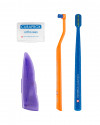













 Swiss premium oral care
Swiss premium oral care
 United Arab Emirates
United Arab Emirates

Fresh, clean braces
As brace wearers know only too well, tiny bits of food stick to brackets and wires. And plaque gets stuck. The ortho kit gives you everything you need to keep things fresh and clean.
Fresh, clean braces
As brace wearers know only too well, tiny bits of food stick to brackets and wires. And plaque gets stuck. The ortho kit gives you everything you need to keep things fresh and clean.

Tools for specialised braces care

Protects teeth and prevents stains

Compact kit for on-the-go use

Tools for specialised braces care

Protects teeth and prevents stains

Compact kit for on-the-go use
• Systematic care: toothbrush, single brush and interdental brushes
• Simple and effective: all-in-one in the Ortho kit
• Practical: a Pocket set is included for travel use
 Swiss premium oral care
Swiss premium oral care

